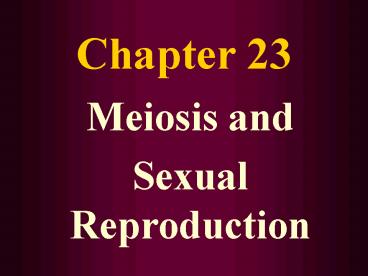Meiosis and PowerPoint PPT Presentation
1 / 38
Title: Meiosis and
1
Chapter 23
- Meiosis and
- Sexual Reproduction
2
Asexual Reproduction (review)
- Single parent gives rise to new offspring by
mitotic cell division - Each new individual receives a set of chromosomes
identical to the parent chromosomes - No variation of hereditary information
3
(I) Sexual Reproduction
- Two parents give rise to new offspring by the
fusion of nuclear materials from two different
cells - Offspring are not identical to the parent
- Variations exist, which increases the species
ability to adapt to the changing environment
4
(A) Gonads
- Sex organs
- 1. Males Testes
- 2. Females Ovaries
5
(A) Gametes
- Sex cells
- 1. Males sperm
- 2. Females ovum
6
(B) Fertilization
- The fusion of the nuclei of one sperm with one
ova (egg) to produce a zygote - Sperm (n) Ovum (n) 2n
- Sperm (23) Ovum (23) 46
7
(C) Haploid
- Also known as monoploid
- Represented by n
- The gametes contain half the number of
chromosomes - Remember, gametes are sex cells that combine to
form new offspring. Therefore gametes are
haploid and once they fuse (combine), they form a
zygote that is diploid
8
(D) Diploid
- Contain the full number (set) of chromosomes
- Represented by 2n
9
Homologous Chromosomes
- Pairs of similar chromosomes
- Humans have 46 chromosomes
- 22 pairs of homologous chromosomes
- 1 pair of sex chromosomes
10
(II) Meiosis
- Known as Reduction Division
- Meiosis is a type of cell division in which the
daughter cell receives only half the number of
chromosomes present in the parent cell
11
23 Pairs of chromosomes of a human cell
- The chromosomes labeled X and Y are the sex
chromosomes - XX female
- XY male
12
(III) Stages of Meiosis
- In meiosis, each cell divides twice
- 1. The first stage is very similar to mitosis
- 2. The second stage is also like mitosis with
the exception that there is - NO replication of chromosomes in the second
phase (meiosis 2)
13
Phases of Meiosis
First Division Second Division
Prophase I Metaphase I Anaphase I Telophase I Prophase II Metaphase II Anaphase II Telophase II
14
Key
- SS single-stranded
- DS double-stranded
15
First Meiotic Division
16
Prophase I
- Replication of SS chromosomes into DS chromosomes
has already occurred. - Each chromosome then pairs up with its
homologous chromosome. - This is known as synapsis.
17
Prophase I
- Each chromosome pair consists of 4 chromatids and
thus is a tetrad. - Crossing over occurrs when segments of DNA are
exchanged between the chromatids found in
tetrads.
18
Metaphase I
- Alignment of the tetrads (4 chromatids) in the
middle of the cell (equatorial plane).
19
Anaphase I
- The homologous chromosomes separate here.
- Chromrsomes are still double stranded.
- The process of separating the homologs is known
as disjunction.
20
Telophase I
- Cytokinesis occurs as in Mitosis however each of
the daughter cells has half the of chromosome
compared to the parent. - After this point, the chromosomes WILL NOT
replicate. - Cells usually start prophase 2 immediately after
telophase 1.
21
SecondMeiotic Division
22
Prophase II
- Chromosomes DO NOT replicate.
- DS chromosomes move towards the equatorial plane.
23
Metaphase II
- Tetrads line up in the MIDDLE of the cell.
- This is sometimes called the equatorial plane or
the metaphase plate.
24
Anaphase II
- DS chromosomes separate.
- SS chromosomes move to opposite ends.
25
Telophase II
- Both daughter cells undergo cytokinesis forming 4
haploid cells. - Thus, each cell has ½ the number of chromosomes
as the parent.
26
- Meiosis
- Diploid (2n) cells divide
- haploid (n) cells
- These cells mature into specialized reproductive
cells (sperm and ova).
27
(III) Sexual Reproduction
- in
- Animals
28
(A) Reproductive System
- Gonads- specialized organs that produce gametes
- a) ovaries - female gonad
- - produce ova (egg)
- b) testes - male gonad
- - produce sperm cell
29
(B) Hermaphrodite
- Contain both male and female reproductive
structures
30
(C) Gametogenesis
- Process by which gametes are produced in the
gonads - Two types
- Spermatogenesis
- Oogenesis
31
Spermatogenesis
- Primary spermatocyte goes through first meiotic
division and form two daughter cells of equal
size - Each daughter cell (secondary spermatocyte) goes
through the second meiotic division forming four
motile sperm cells of equal size
32
Oogenesis
- The primary oocyte goes through first meiotic
division and the cytoplasm of the cell is divided
unequally - The larger daughter cell is called the secondary
oocyte and the smaller daughter cell is called
the polar body - During second meiotic division, 1 mature ovum is
produced and 3 polar bodies
33
Comparison of Ova and Sperm
- Egg cells contain stored food in the form of
yolk. - Egg cells are larger than sperm.
- Sperm are motile, egg cells sessile (cant move
on their own).
34
Fertilization
- Union of a haploid sperm nucleus with a haploid
egg nucleus - This results in a diploid zygote with the full
number of chromosomes
35
Two types of Fertilization
- Internal Fertilization
- External Fertilization
36
Internal Fertilization
- Takes place inside the body of the female
- Less eggs are required
- Ex mammals and birds
37
External Fertilization
- Eggs are fertilized outside the body of the
female - Large number of eggs are required
- This type of fertilization is found in an aquatic
environment - Ex fish, frogs, salamanders.
38
(No Transcript)

